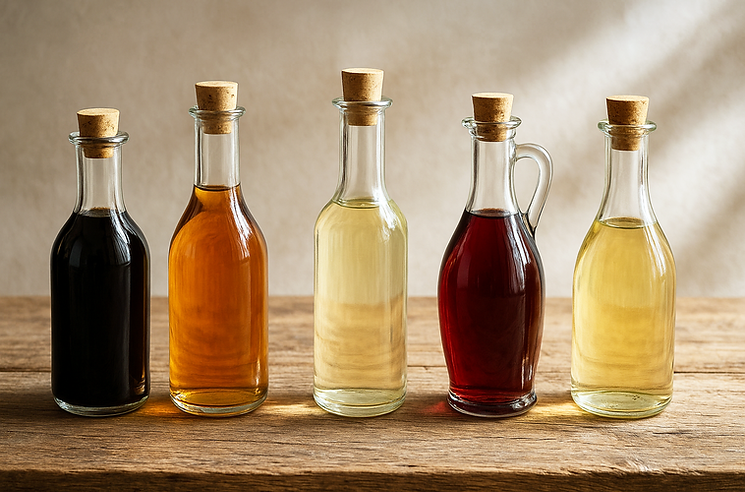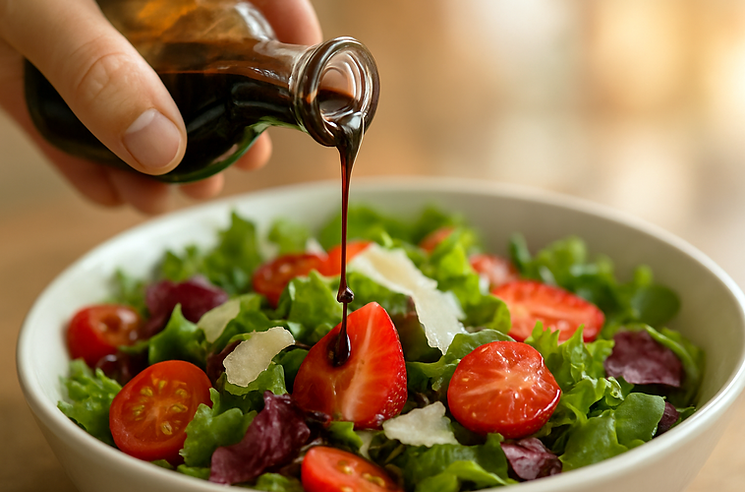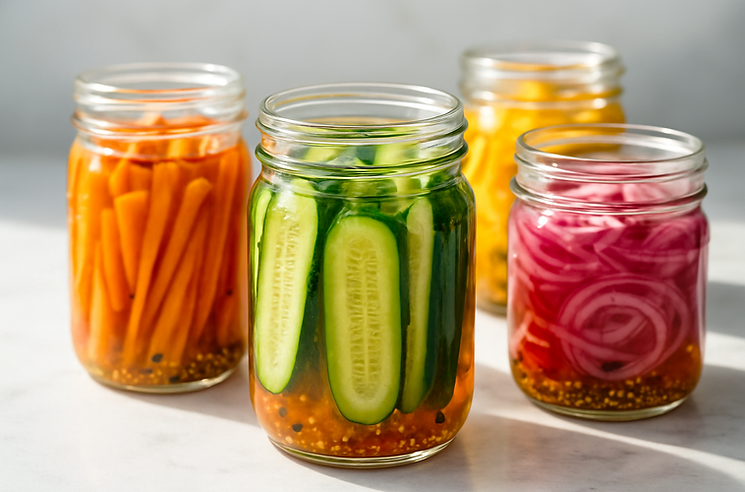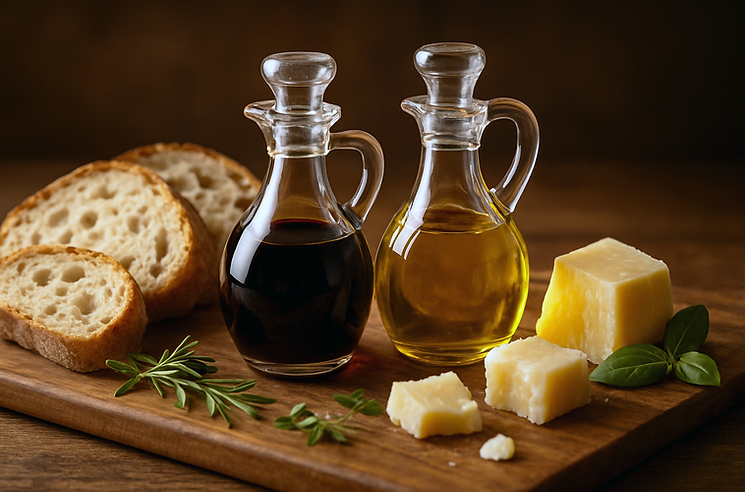Vinegar Explained:
The Different Types & When to Use Them
From sharp white vinegar to aged balsamic, discover what each vinegar brings to the kitchen and how to choose the right one for your dish.

A variety of vinegars in bottles, showing common types you'll find in stores.
What is Vinegar?
Vinegar is a versatile kitchen staple made through the fermentation of various natural sources like fruits, grains, or sugar. At its core, vinegar is a liquid containing acetic acid, which gives it its distinctive tangy taste and preserving qualities.
But vinegar is much more than just acidity — it can brighten and balance flavours, tenderize meats, preserve foods, and even transform dishes by adding complexity and depth. Different vinegars bring unique aromas, sweetness levels, and intensity, so understanding their differences helps you choose the right one for every culinary purpose.
What's the Difference Between Vinegars?
The key differences come from what the vinegars are made of, how they’re fermented, their acidity level, flavour profile, and colour. Here are the main factors:
-
Base ingredient: grapes, apples, rice, malted barley, sugarcane, etc.
-
Production method: distilled, fermented, aged, infused
-
Acidity level: usually between 4% and 7% acetic acid
-
Flavour notes: from sharp and tangy to sweet and mellow
At a Glance: The Main Types of Olive Oil
Type | Base Ingredient | Flavour Profile | Best For |
|---|---|---|---|
White Distilled | Grain alcohol | Sharp, clean, very acidic | Pickling, cleaning, marinades |
Apple Cider | Apples | Fruity, slightly sweet | Dressings, sauces, drinks |
Balsamic | Trebbiano grapes | Sweet, complex, syrupy | Finishing, glazes, salads |
Red Wine | Red grapes | Bold, fruity, tangy | Sauces, marinades, stews |
White Wine | White grapes | Light, crisp, mild | Dressings, seafood, deglazing |
Rice Vinegar | Rice | Mild, slightly sweet | Asian dishes, sushi, pickling |
Malt Vinegar | Barley malt | Malty, tangy | Fish and chips, marinades |

Balsamic vinegar being drizzled over a fresh salad.
White Distilled Vinegar
A highly purified vinegar made by fermenting grain alcohol. It’s very sharp and acidic, making it perfect for pickling, cleaning, or when you want strong acidity without extra flavor.
-
Best for: Pickling, cleaning, preserving
-
Tip: Avoid using it raw in salad dressings unless you want a very sharp kick.
Apple Cider Vinegar
Made from fermented apple juice, it has a mild, fruity flavour with subtle sweetness. Often used in dressings, marinades, and health tonics.
-
Best for: Salad dressings, sauces, detox drinks
-
Tip: Choose unfiltered, organic apple cider vinegar for maximum flavour and health benefits.
Balsamic Vinegar
Originating in Italy, traditional balsamic is made from reduced grape must (freshly crushed grape juice including skins, seeds, and stems) aged for years in wooden barrels. It’s rich, sweet, and complex — perfect for finishing dishes or adding depth to sauces.
-
Best for: Drizzling on salads, grilled veggies, fruit, or cheese
-
Tip: Use sparingly — a little balsamic goes a long way.
Red and White Wine Vinegars
Both made from fermented wine, these vinegars offer different flavour intensities. Red wine vinegar is bolder and more robust, great for hearty dishes, while white wine vinegar is lighter and ideal for delicate recipes.
-
Best for: Red wine — marinades, stews; White wine — seafood, dressings
Rice Vinegar
Made from fermented rice, this vinegar is milder and slightly sweet, making it a staple in many Asian cuisines, especially sushi rice seasoning.
-
Best for: Asian cooking, sushi rice, pickling
Malt Vinegar
Made from malted barley, malt vinegar has a distinctive malty flavour. It’s a traditional condiment for fish and chips and adds a unique tang to marinades and sauces.
Best for: Fish and chips, marinades, dressings

Vegetables freshly pickled using white vinegar.
Does the Type of Vinegar Really Matter?
Absolutely. The vinegar you choose will affect acidity, sweetness, and aroma — shaping the balance of your dish. Some vinegars are meant to be cooked with; others are best used raw to preserve their delicate flavours.
Can I Substitute a Different Vinegar in My Recipe?
Vinegars vary widely in flavor, acidity, and intensity, so substitutions aren’t always one-to-one. If you’re in a pinch, here are some general tips:
-
Match acidity levels: Try to swap with a vinegar that has a similar sharpness to maintain balance in your dish. For example, white distilled vinegar can often replace apple cider vinegar if you want similar acidity but less fruity flavor.
-
Consider flavor profiles: Some vinegars are sweet (balsamic, apple cider) while others are sharp and neutral (white distilled). Using a vinegar with a very different flavor can change the character of your dish.
-
Adjust quantities to taste: Stronger vinegars may require you to use less to avoid overwhelming the flavor. Add just a little at a time if you are unsure.
If flavor is critical — like in salad dressings or finishing sauces — it’s best to use the vinegar the recipe recommends. But for pickling or marinades, there’s often more flexibility.
Are Wine and Cider Vinegars Alcoholic?
Many vinegars, like wine and cider vinegar, start with alcoholic bases, which can be a concern if you avoid alcohol for personal, dietary, or religious reasons. The good news is: the fermentation process converts most alcohol into acetic acid, so most vinegars contain very little to no alcohol by the time they reach your kitchen. However, if you prefer to avoid even trace amounts or the association with alcohol, here are some alternatives:
-
Use distilled white vinegar: It’s alcohol-free, very acidic, and neutral in flavor—great for most cooking needs.
-
Try rice vinegar: Mild, slightly sweet, and alcohol-free, it works well in dressings and light sauces.
-
Experiment with lemon or lime juice: These fresh acids provide bright acidity without alcohol and can substitute in many recipes.
Always consider the flavor profile you want to maintain—lemon juice adds citrus notes, while distilled vinegar is sharper and cleaner. When in doubt, test in small amounts and adjust to taste.
How to Store Vinegar
Store vinegar in a cool, dark place, tightly sealed. Most vinegars have a long shelf life due to acidity but may change flavour if exposed to heat or light over time.

A cheese board with balsamic vinegar and olive oil.
Final Thoughts
Vinegars are more than just a seasoning — they’re powerful flavour enhancers with diverse profiles. Explore different types, experiment with pairings, and watch how vinegar can brighten and balance your cooking.





